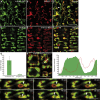The endoplasmic reticulum is the main membrane source for biogenesis of the lytic vacuole in Arabidopsis
- PMID: 24014545
- PMCID: PMC3809542
- DOI: 10.1105/tpc.113.114827
The endoplasmic reticulum is the main membrane source for biogenesis of the lytic vacuole in Arabidopsis
Abstract
Vacuoles are multifunctional organelles essential for the sessile lifestyle of plants. Despite their central functions in cell growth, storage, and detoxification, knowledge about mechanisms underlying their biogenesis and associated protein trafficking pathways remains limited. Here, we show that in meristematic cells of the Arabidopsis thaliana root, biogenesis of vacuoles as well as the trafficking of sterols and of two major tonoplast proteins, the vacuolar H(+)-pyrophosphatase and the vacuolar H(+)-adenosinetriphosphatase, occurs independently of endoplasmic reticulum (ER)-Golgi and post-Golgi trafficking. Instead, both pumps are found in provacuoles that structurally resemble autophagosomes but are not formed by the core autophagy machinery. Taken together, our results suggest that vacuole biogenesis and trafficking of tonoplast proteins and lipids can occur directly from the ER independent of Golgi function.
Figures








References
-
- Amelunxen F., Heinze U. (1984). Zur entwicklung der vacuole in testa-zellen des leinsamens. Eur. J. Cell Biol. 35: 343–354
-
- Berjak P. (1972). Lysosomal compartmentation: Ultrastructural aspects of the origin, development, and function of vacuoles in root cells of Lepidium sativum. Ann. Bot. (Lond.) 36: 73–81
-
- Boutté Y., Grebe M. (2009). Cellular processes relying on sterol function in plants. Curr. Opin. Plant Biol. 12: 705–713 - PubMed
Publication types
MeSH terms
Substances
LinkOut - more resources
Full Text Sources
Other Literature Sources

